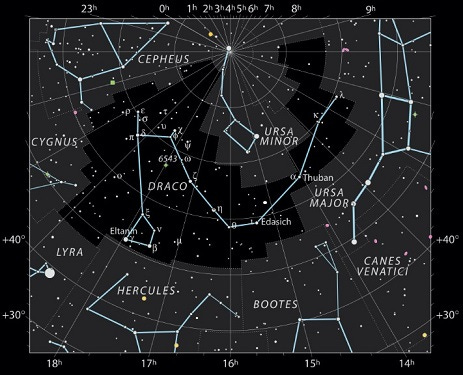This near-Earth asteroid was discovered on 2024-08-07, 21:11:57.2928 UT (9° Cap 58'37.58" Rx) at M22-ATLAS in South Africa, and it was described by the researchers Carlos de la Fuente Marcos and Raúl de la Fuente Marcos here. According to the latest solution date here, its orbital cycle is 1.018533 yrs. This asteroid has been recently suggested here to most likely be ejecta from an impact on our Moon, as well the second NEO after Kamo`oalewa that originated as ejecta. Its diameter is 8 meters. The perihelion is 2024-11-24, 21:26:15 UT (11° Leo 04'52.62" Rx), based on the JPL orbital solution on 2025-01-22.
The Earth captured it, and it will become a ‘mini-moon’ from Sep. 29 to Nov. 25. It’s referred to as a “temporarily captured fly-by” (we know of three or four of these) unlike some of the other “captures,” e.g., 469219 Kamo`oalewa, thought to be once part of our Moon. Kamo`oalewa is the most stable of the Earth’s quasi-satellites, “captured” in the late-19th century and will be around for several centuries at least. The “temporarily captured orbiters” (2006RH120 and 2020CD3) are also interesting. I’ve tracked these since discovery.
All of these “captured” objects, even the tiniest one, have astrological significance, especially Kamo`oalewa (41 meters in diameter), and should be tracked as they transit our natal charts. Do astrologers track them, look at natal placements, and so forth? Without an ephemeris with ecliptic-of-date coordinates, it’s impossible, right? We believe they have a message for us, even if short-lived, as with the “temporarily captured fly-by” 2024PT5. It will be retrograde the entire time while looping the Earth, spending most of the time in Tropical Leo from Oct. 6 through Dec. 15. For those who might continue to track it further and, thus, to better understand its significance, it’s stationary direct (SD) on Feb. 1, 2025, 19:51:37 UT (4° Can 21'45.10"), the day 4486 Mithra is SD as well, 18:08:01 UT (29° Tau 06'56.458").
On Sep. 29, 9:44:54.68 UT, the day it began its loop around the Earth, it was conjunct the fixed star Coxa (Chertan) at 13° Vir. 46'08.97", an influence suggesting a Great Oracle or Prophet.
2024PT5 is visible in the northern hemisphere in the constellation Draco from Aug. 29 to Oct. 13, then moves into Ursa Minor until Dec. 4.
Enjoy your research!
For a complimentary Daily Greenwich Noon Ephemeris (Aug. 1 – Dec. 31, 2024) of this ‘mini-moon’, click here - updated 2025-01-23. For those who would like an ephemeris for 2025 or any other year(s), click here. Those who support our work may simply request this free of charge.
_____________________
Additional Reading:
1. https://en.wikipedia.org/wiki/2024_PT5
2. https://earthsky.org/space/earth-asteroid-mini-moon-for-2-months-2024/
3. https://shorturl.at/rSikm
4. https://minorplanetcenter.net/db_search/show_object?utf8=%E2%9C%93&object_id=2024 PT5
5. https://ssd.jpl.nasa.gov/tools/sbdb_lookup.html#/?sstr=2024PT5
6. https://theconversation.com/earth-is-getting-a-tiny-new-mini-moon-it-wont-be-the-first-or-the-last-239507
7. https://twitter.com/i/status/1833588006353310110
8. https://blogs.nasa.gov/planetarydefense/2024/10/02/nasa-to-track-asteroid-2024-pt5-on-next-close-pass-january-2025/
9. https://iopscience.iop.org/article/10.3847/2041-8213/ad9ea8/pdf
10. https://upload.wikimedia.org/wikipedia/commons/2/2e/Animation_of_2024_PT5_around_Earth_-_Close_approach.gif
_____________________






As mentioned in our article here, the ‘mini-moon’ is retrograde during its entire loop of the Earth from Sep. 29 to Nov. 25, 2024. On Oct. 13, 15:37:47.2 UT, it moved from the constellation Draco into Ursa Minor's boundary, of which corresponds to 22° Leo 34'28.51" Rx.
For those who have natal placements in Tropical Leo, it might be interesting to watch the ‘mini-moon’ from Oct. 6 through Dec. 15. We know Kamala Harris has Mars at 21° Leo 17'27.76" in the 3rd, so it’s not too difficult to calculate when the ‘mini-moon’ will transit that natal planet tomorrow, Oct. 15, 6:23:32 UT, just a few hours from now. Mars rules her 11th of friends, social groups and hopes for the future. How would that manifest, you might wonder?
It's good to have an accurate ephemeris as well, which we presented Sep. 16, but unless we know where the ‘mini-moon’ is natally in our charts and in those of others, the various placements in Leo, the relevance of this looping of the Earth will probably go unnoticed. For those with interest in fixed stars, what might we see when it conjuncts Pherkad today, 9.41 UT, and Kochab on Nov. 7?
With each updated orbital solution shown at SBDB (Oct. 11), we update our ephemeris. This ‘mini-moon’ orbit is pretty well-known, so only slight changes will be noticed.
Enjoy your research!